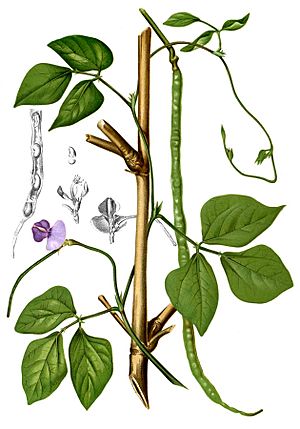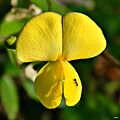Vigna facts for kids
Quick facts for kids Vigna |
|
|---|---|
 |
|
| Cowpea (Vigna unguiculata) | |
| Scientific classification |
|
| Kingdom: | Plantae |
| Clade: | Tracheophytes |
| Clade: | Angiosperms |
| Clade: | Eudicots |
| Clade: | Rosids |
| Order: | Fabales |
| Family: | Fabaceae |
| Subfamily: | Faboideae |
| Tribe: | Phaseoleae |
| Subtribe: | Phaseolinae |
| Genus: | Vigna Savi |
| Subgenera | |
|
|
| Synonyms | |
|
|
Vigna is a group of flowering plants. They belong to the legume family, called Fabaceae. You can find these plants all over the world, especially in warm, tropical areas.
This group includes many well-known plants that we eat. Some of them used to be in a different plant group called Phaseolus. Scientists tell Vigna apart from Phaseolus by looking at their tiny parts, like their pollen and how their flowers are shaped.
Vigna plants are also sometimes confused with another group called Dolichos. However, they have different stigma shapes, which is a part of the flower.
Contents
What are Vigna Plants Like?
Vigna plants are usually small, soft plants called herbs. Sometimes, they can be slightly woody, like small shrubs. Their leaves are divided into three smaller leaflets.
The flowers grow in clusters and can be yellow, blue, or purple. They look a bit like pea flowers. After the flowers, the plant makes a fruit called a legume pod. These pods hold the seeds, which are the beans we eat!
Beans You Might Know
Many Vigna species are important food sources around the world. You might have eaten some of these:
- The adzuki bean (V. angularis)
- The black gram (V. mungo)
- The cowpea (V. unguiculata), which includes the famous black-eyed pea
- The mung bean (V. radiata)
These beans can be eaten whole. They can also be made into a paste or grown into bean sprouts.
How Vigna Got Its Name
The name Vigna comes from a man named Domenico Vigna. He was an Italian botanist in the 1600s. A botanist is a scientist who studies plants. Domenico Vigna was also in charge of the botanical garden in Pisa, Italy.
Uses of Vigna Plants
Besides being a food source for people around the world, Vigna plants have other uses. For example, some types of Vigna have roots that grow into tubers. These tubers were traditionally eaten by Aborigines in the Northern Territory of Australia.
Many Types of Vigna
There are at least 90 different kinds of Vigna plants! Scientists group them into smaller categories called subgenera. Here are a few examples from some of these groups:
Subgenus Ceratotropis
- Vigna aconitifolia – also known as moth bean
- Vigna angularis – the adzuki bean
- Vigna mungo – the black gram
- Vigna radiata – the mung bean
- Vigna umbellata – known as ricebean
Subgenus Vigna
- Vigna luteola – sometimes called Dalrymple vigna
- Vigna subterranea – known as Bambara groundnut
- Vigna unguiculata – the cowpea, which includes the black-eyed pea and yardlong bean
Images for kids
See also
 In Spanish: Vigna para niños
In Spanish: Vigna para niños



